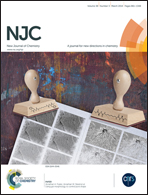The structures and properties of halogen bonds involving polyvalent halogen in complexes of FXOn (X = Cl, Br; n = 0–3)–CH3CN†
Abstract
To explore the nature of unconventional halogen bonds, the halogen bonds between a series of halides FXOn (X = Cl, Br; n = 0–3) and CH3CN have been studied at M05-2X/6-311++G(d,p), MP2/aug-cc-pVTZ and CCSD(T)/aug-cc-pVTZ levels. Our calculations reveal that the electrostatic potentials of these hypervalent halogen atoms are greatly different to those of monovalent halogen atoms and, accordingly, the strength and interaction modes of these halogen bonds show different characteristics. For complexes of monovalent and heptavalent halides, only one interaction mode was found, but for those of tervalent and pentavalent halides, three kinds of stable configurations with different interaction modes were recognized. Configuration I is a linear structure formed by a single halogen bond, while configurations II and III are cyclic structures formed by the cooperation of a halogen bond and a hydrogen bond. From an energy point of view, monovalent halides form the strongest halogen bonds, and heptavalent halides feature the weakest halogen bonds. For tervalent and pentavalent halides, the interaction energies of the three configurations are similar. In the two cyclic configurations of complexes formed by tervalent and pentavalent halides, due to the competition of the halogen bond with the hydrogen bond, the halogen bonds are weaker than that of configuration I. NBO analysis indicates that the three configurations of complexes display different donor–acceptor orbital interactions. AIM and LMO-EDA analysis reveal that the electrostatic interaction is the dominant driving force for the formation of the complexes, and all the halogen and hydrogen bonds in these complexes are closed-shell interactions.


 Please wait while we load your content...
Please wait while we load your content...